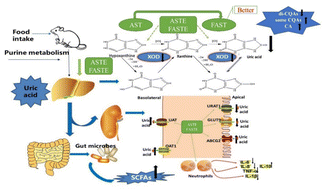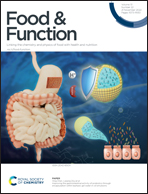Effect of Lactobacillus acidophilus fermentation on the composition of chlorogenic acids and anti-hyperuricemia activity of Artemisia selengensis Turcz†
Abstract
Background: Lactobacillus fermentation has become a typical food processing method with the development of the modern food industry. Aims: This study aimed to assess the effects of Lactobacillus acidophilus NCUF202.2 fermentation on Artemisia selengensis Turcz (AST) in relieving hyperuricemia (HUA) and the mechanisms involved. Results: The fermented Artemisia selengensis Turcz extracts (FASTE) could significantly increase the content of free polyphenol and enhance the inhibitory effect on xanthine oxidase (XOD) in vitro. The result of ultrafiltration coupled with UPLC-MS/MS screened out the components that might be combined with XOD in the caffeoylquinic acids (CQAs) of Artemisia selengensis Turcz extracts (ASTE) as 5-CQA, 3-CQA, 4-CQA, 1-CQA, 3,4-diCQA, 3,5-diCQA, 1,5-diCQA and 4,5-diCQA as well as caffeic acid (CA) of FASTE except the above. Our results also showed that ASTE and FASTE could alleviate HUA in rats. In contrast, FASTE had a better ability to reduce serum adenosine deaminase (ADA) activity than ASTE. Furthermore, FASTE could restore catalase (CAT) in HUA model rats in vivo, and superoxide dismutase (SOD) activity to a better degree, thereby inhibiting the production of excess malondialdehyde (MDA). Under the intervention of ASTE and FASTE, the levels of serum pro-inflammatory and anti-inflammatory factors in rats tended to be normal. However, FASTE could increase the expression of the uric acid secretion protein OAT1 and decrease the expression of reabsorption proteins URAT1 and GLUT9 in model rats, thereby reducing the serum uric acid (SUA) level in model rats. ASTE and FASTE can increase the abundance of beneficial bacteria, such as Bifidobacterium and Akkermansiaceae. Conclusion: Overall, part of diCQAs and CQAs was decomposed after fermentation. FASTE had a more substantial HUA-relieving effect than ASTE. It is expected to be applied to functional foods and contribute to the research and development of uric acid lowering functional foods.



 Please wait while we load your content...
Please wait while we load your content...